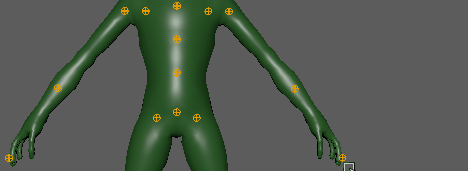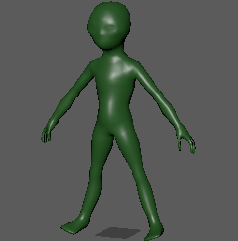
- From the HumanIK window Start Pane, select Quick Rig Tool ()
- Select
- From the Rigging menu set, select . The HumanIK window opens. From the Start Pane, select Quick Rig
- From the Rigging shelf, select Quick Rig
The Quick Rig tool lets you quickly rig an empty biped character mesh. You can use this tool two ways: using the automatic function or a step-by-step workflow. While the automatic One-Click option is good for standard character meshes, the Step-by-Step option gives you more control over the automated rigging process.
See Create an automatic character rig for a mesh for an explanation of how to use the automated rigging process.
- Character menu
- Use the drop-down menu to select a character mesh to rig.
- Refresh Character List

- Updates the Character field with the selected mesh.
- Create a new Character

- Create a new generic character that you can use with the Quick Rig tool.
- Rename Character

- Lets you rename the mesh that is to be characterized.
- Delete Character

- Deletes the created character mesh.
One-Click
Click One-Click to use an automatic option to rig your character mesh. This procedure works best if your Character Mesh is a biped and without too many geometry defects.
- Auto-Rig!
- With an empty Character mesh(es) selected in your scene, click Auto-Rig!. Your mesh(es) is characterized with a HumanIK rig and is ready to animate.
Step-By-Step
Choose the Step-By-Step option to rig your empty character mesh in 5 steps.
Note: Your character mesh needs to be in a Y-up worldspace, facing the Z-axis.
See
Create an automatic character rig for a mesh for a detailed workflow.
- Geometry area
- This area is where you specify what mesh(es) in the scene are rigged.
-
- Add Selected Meshes

- Populates the
Geometry list with the selected meshes.
Note: Some meshes have auxiliary meshes that accompany them, for example, eyes, hair, accessories, and so on. Use the Select All Meshes
 to make sure that these are selected as well.
to make sure that these are selected as well.
- Select All Meshes

- Adds all selected meshes in the scene to the Geometry list.
- Clear all meshes

- Empties the Geometry list.
- Add Selected Meshes
- Guides area
- Guides are helper markers that you use to align the rig.
-
- Embed Method
- This area lets you specify what sort of mesh is used and how best to rig it. There are four options. Click the Help icon
 to see a description of the selected method.
to see a description of the selected method.
-
- Perfect Mesh (no voxelization)
- This method works for "perfect meshes", that is, meshes that are closed, watertight, 2-manifold and without self-intersection or interior/hidden geometry. It segments the interior region of the mesh from the exterior using a pseudo-normal test. It does not use voxelization. If mesh conditions are not respected, the segmentation is likely to be wrong. This can make the segmentation process significantly longer and prevent successful skeleton embedding.
- Watertight mesh (flood fill)
- This method works for "watertight meshes", that is, meshes for which faces completely separate the interior region of the mesh from the exterior. The mesh can have degenerated faces, wrong face orientation, self-intersection, etc. The method uses surface voxelization to classify as part of the interior region all voxels intersecting with a mesh face. It then performs flood-filling from the outside, marking all reached voxels as part of the exterior region of the model. Finally, all unreached voxels are marked as part of the interior region. This method works so long as the mesh is watertight, i.e. without holes up to the voxelization resolution. Otherwise, flood-filling reaches the interior region and creates inaccurate segmentation.
- Imperfect mesh (flood fill + growing)
- This method works for meshes where holes could make the flood-filling step reach the interior region of the mesh, but that have face orientation consistent enough so filling them is possible. First, it uses surface voxelization to classify as part of the interior region all voxels intersecting with a mesh face. It then alternates flood-filling and growing steps. The flood-filling tries to reach all voxels from the outside so that unreached voxels are marked as part of the interior region. The growing step uses a relatively computation-intensive process to check for interior voxels in all neighbors to those already identified. Any voxel identified as interior is likely to fill holes, allowing subsequent flood-filling steps to identify more interior voxels.
- Polygon soup (repair)
- This method has no manifold or face orientation requirements. It reconstructs a mesh that wraps the input mesh with a given offset (3 times the voxel size) and uses this perfect 2-manifold mesh to segment the interior region from the exterior region of the model. Because of the offset, it might lose some of the details and merge parts that are proximal. However, this usually is not an issue with common models where body parts are not too close to one another.
-
- Resolution field
- Select a resolution from this field to use with the rig. Higher-resolutions take more time to process.
- Guide Settings
- The area assigns guides that help Maya align the skeleton joints with the appropriate positions on your mesh.
-
- Symmetry
- Ensures that guides map to center joints (hips, spine, and neck,) are centered and map to symmetrical joints (shoulders, arms and legs).. The center/mirror plane is the YZ plan that passes through the center of the mesh(es) bounding box. It is recommended to leave this option turned on unless your character is intended to be unequally proportioned.
- Center
- Lets you set how many guides the skeleton will use to create the rig. The default HumanIK skeleton has 3 spine nodes, and one neck and shoulder/clavicle each.
Note: If you enter a number in the Spine field and then count the guides in the Outliner, it appears that there is one spine guide less than you specified. This is because the last spine guide is named shoulders, and is the joint between each shoulder. It occupies the same position as the last HIK spine joint.
- Create/Update
- Click Create/Update to add guides to your character mesh.
- Delete Guides

- Clears guides from the character mesh.
- User Adjustment of Guides area
- You can manually position the guide helpers that Maya uses to create the skeleton to achieve a better match with your character mesh using the Move tool. Use the options below to help with positioning.
-
- Mirror Left to Right/Mirror Right to Left

- Uses the position of the selected guides to align the opposite side's guides. Center guides are snapped to the mirror plane
-

-
Note: The Mirror Left to Right tool uses the selected guides on the character's left side when facing the character (that is, guides on the character’s right side) and applies a mirror plane offset to its symmetrical counterpart on the character's right side when facing the character (that is, on the character’s left side).
The Mirror Right to Left tool works in the opposite way.
- Select Guides

- Selects all the guides.
- Show/Hide all Guides

- Toggles the display of guides on and off.
-

- Enable XRay Joints

- Turns on the XRay joints in all viewports.
- Mirror Left to Right/Mirror Right to Left
- Character Generation
- This area lets you generate the character skeleton and HumanIK control rig.
-
- Skeleton Settings
-
- T-Stance Correction
- Activate this option to characterize the new HumanIK skeleton in a T-Stance pose once its bones are resized to match the embedded skeleton, after which the control rig restores the skeleton back to the embedded pose. This is the recommended option; if the T-Stance Correction option is turned off, the HumanIK skeleton is characterized in the embedded pose, which gives unexpected results in certain situations when the embedded pose is not a T-Stance (A-Stance is a popular alternative), for example with animation retargeting.
- Orient Joints
- Activate this option to make the skeleton joints' x-axis point toward their respective child-joints, as opposed to the world axes and the joints' z-axis so that if you animate the Z rotation for any joint:
- (positive or negative direction) creates symmetrical animation on both sides
- (positive direction) creates more “natural” animation for this joint (elbows and knees bend the right way, clavicles go up, and so on.)
- Turn off this option if you want to align all joints with the world frame. Each joint's local axes have the orientation of the world axis.
- Skeleton and Control rig menu
- Choose whether you want to create a Skeleton with a Control Rig or only a Skeleton from this menu.
- Create/Update
- Click Create/Update to create a Skeleton with or without a Control Rig for your character mesh.
-

- Skinning area
- This area lets you control the way the mesh skin is attached to the skeleton.
-
- Binding Method
- Choose a skin binding method from this menu. Geodesic Voxel Binding is the default setting as it provides excellent binding for most mesh types.
- Click the Settings icon
 to open the
Bind Skin Options, where you can customize your skin binding preferences.
to open the
Bind Skin Options, where you can customize your skin binding preferences.
- Create/Update
- Click Create/Update to skin your character which completes the rigging process for your character mesh.
-

- Delete Skin

- Deletes the created character skin.